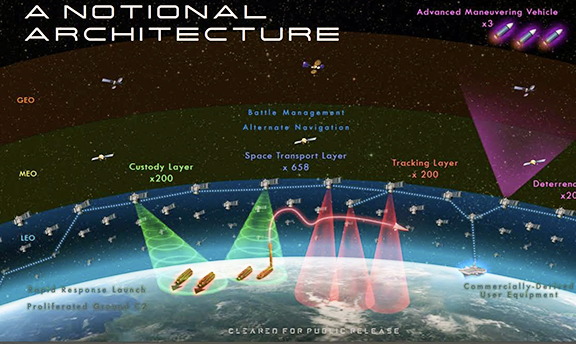The Space Development Agency’s (SDA) mission is to rapidly develop and deploy a threat-driven, next-generation space architecture to counter near-peer efforts to contest or deny our space-based systems.

Figure 1. Notional Architecture (from SDA 60-Day Study).
To further the agency’s mission, SDA requests information from industry related to satellite bus, payload, applique, and launch concepts that can contribute to an agile, responsive next-generation space architecture.
Please access this direct link for the SDA’s Request for Information (RFI) for additional details and submission instructions.
SDA has developed a notional suite of capabilities, as depicted in Figure 1, to include multiple constellations (or “layers”) addressing the eight priorities listed next, with e layer providing an integral and integrated capability to the overall architecture.
1. Persistent global surveillance for advanced missile targeting,
2. Indications, warning, targeting, and tracking for defense against advanced missile threats,
3. Alternate positioning, navigation, and timing (PNT) for a GPS-denied environment,
4. Global and near-real time space situational awareness,
5. Development of deterrent capability,
6. Responsive, resilient, common ground-based space support infrastructure (e.g., ground stations and launch capability),
7. Cross-domain, networked, node-independent battle management command, control, and
communications (BMC3), including nuclear command, control, and communications (NC3),
8. Highly-scaled, low-latency, persistent, artificial-intelligence-enabled global surveillance.
The SDA’s notional architecture is predicated on the availability of a ubiquitous data and communications transport layer and assumes the use of small, mass-produced satellites (50 to 500 kg.) and associated payload hardware and software. The SDA is considering the use of transport layer spacecraft as substrates for other layers, allowing for the integration of appropriate payloads based on each layer’s needs. Seven layers are proposed:
1. Space Transport Layer: Global, persistent, low-latency data and communications proliferated
“mesh” network to provide 24×7 global communications.
2. Tracking Layer: Indications, warning, targeting, and tracking of advanced missile threats.
3. Custody Layer: 24×7, all-weather custody of all identified time-critical targets.
4. Deterrence Layer: Space Situational Awareness (SSA) of, and rapid access to, the cislunar
volume.
5. Navigation Layer: Alternate Positioning, Navigation and Timing (PNT) for GPS-denied
environments.
6. Battle Management Layer: Distributed, artificial intelligence-enabled Battle Management
Command, Control and Communications (BMC3), to include self-tasking, self-prioritization
(for collection), on-board processing, and dissemination, supporting delivery of perishable
space sensor-derived data products directly to tactical users.
7. Support Layer: Mass-producible ground command and control capabilities, user terminals,
and rapid-response launch services (small- to medium-class).
Proposed concepts should align to one or more of the layers described above. SDA prefers
comprehensive solutions that include open architectures (e.g., buses that support multiple payloads
and software appliques, and payloads/software capable of integration aboard multiple buses) and
leverage commercial capabilities, existing or planned.
Please note that the SDA plans to hold an Industry Day in the near future. A separate announcement will be posted at www.fbo.gov with the date, location, and registration details.

